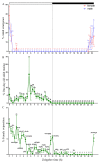Circadian Activity and Clock Genes in Pachycrepoideus vindemmiae: Implications for Field Applications and Circadian Clock Mechanisms of Parasitoid Wasps
- PMID: 37233114
- PMCID: PMC10231066
- DOI: 10.3390/insects14050486
Circadian Activity and Clock Genes in Pachycrepoideus vindemmiae: Implications for Field Applications and Circadian Clock Mechanisms of Parasitoid Wasps
Abstract
Despite the importance of circadian rhythms in insect behavior, our understanding of circadian activity and the molecular oscillatory mechanism in parasitoid wasp circadian clocks is limited. In this study, behavioral activities expected to be under the control of the endogenous circadian system were characterized in an ectoparasitoid wasp, Pachycrepoideus vindemmiae. Most adults exhibited emergence between late night and early morning, while mating only occurred during the daytime, with a peak at midday. Oviposition had three peaks in the early morning, late day, or early night and late night. Additionally, we identified eight putative clock genes from P. vindemmiae. The quantitative PCR (qPCR) results indicate that most clock genes showed significant rhythmic expressions. Our comparative analysis of clock genes in P. vindemmiae and 43 other parasitoid wasps revealed that none of the wasps possessed the timeless and cry1 genes commonly found in some other insect species, suggesting that the circadian clock system in parasitoid wasps is distinct from that in other non-Hymenoptera insects such as Drosophila. Thus, this study attempted to build the first hypothetical circadian clock model for a parasitoid wasp, thus generating hypotheses and providing a platform for the future functional characterization of P. vindemmiae clock genes as well as those of other parasitoid wasps. Finally, these findings on P. vindemmiae circadian activity will aid the development of effective field release programs for biological control, which can be tested under field conditions.
Keywords: Pachycrepoideus vindemmiae; circadian rhythms; clock genes; field application; parasitoid wasp.
Conflict of interest statement
The authors declare no conflict of interest.
Figures





Similar articles
-
Identification and Comparative Analysis of Venom Proteins in a Pupal Ectoparasitoid, Pachycrepoideus vindemmiae.Front Physiol. 2020 Jan 24;11:9. doi: 10.3389/fphys.2020.00009. eCollection 2020. Front Physiol. 2020. PMID: 32038312 Free PMC article.
-
Isolation and characterization of polymorphic microsatellite loci for Pachycrepoideus vindemmiae (Rondani) (Hymenoptera: Pteromalidae).Genet Mol Res. 2015 Mar 13;14(1):1798-801. doi: 10.4238/2015.March.13.7. Genet Mol Res. 2015. PMID: 25867324
-
Peppermint essential oil inhibits Drosophila suzukii emergence but reduces Pachycrepoideus vindemmiae parasitism rates.Sci Rep. 2020 Jun 4;10(1):9090. doi: 10.1038/s41598-020-65189-5. Sci Rep. 2020. PMID: 32499494 Free PMC article.
-
Genetics and molecular biology of rhythms in Drosophila and other insects.Adv Genet. 2003;48:1-280. doi: 10.1016/s0065-2660(03)48000-0. Adv Genet. 2003. PMID: 12593455 Review.
-
Molecular mechanism and cellular distribution of insect circadian clocks.Annu Rev Entomol. 2000;45:769-93. doi: 10.1146/annurev.ento.45.1.769. Annu Rev Entomol. 2000. PMID: 10761596 Review.
Cited by
-
Evaluation of Pupal Parasitoids Trichomalopsis ovigastra and Pachycrepoideus vindemiae as Potential Biological Control Agents of Bactrocera dorsalis.Insects. 2025 Jul 10;16(7):708. doi: 10.3390/insects16070708. Insects. 2025. PMID: 40725338 Free PMC article.
References
-
- Barbosa P., Frongillo E.A. Influence of light-intensity and temperature on locomotory and flight activity of Brachymeria intermedia [Hym.: Chalcididae] a pupal parasitoid of gypsy moth. Entomophaga. 1977;22:405–411. doi: 10.1007/BF02373266. - DOI
-
- Nishimura T., Fujii T., Sakamoto K., Maeto K. Daily locomotor activity of the parasitoid wasp Meteorus pulchricornis (Hymenoptera: Braconidae) that attacks exposed lepidopteran larvae. Appl. Entomol. Zool. 2015;50:525–531. doi: 10.1007/s13355-015-0362-7. - DOI
-
- Kawaguchi M., Tanaka T. Time and location of larval emergence of the endoparasitoid Cotesia kariyai (Hymenopter: Braconidae) from the lepidopteran host Pseudaletia separata (Lepidoptera: Noctuidae) Ann. Entomol. Soc. Am. 1999;92:101–107. doi: 10.1093/aesa/92.1.101. - DOI
-
- Pompanon F., Fouillet P., Bouletreau M. Emergence rhythms and protandry in relation to daily patterns of locomotor activity in Trichogramma species. Evol. Ecol. 1995;9:467–477. doi: 10.1007/BF01237829. - DOI
Grants and funding
LinkOut - more resources
Full Text Sources

